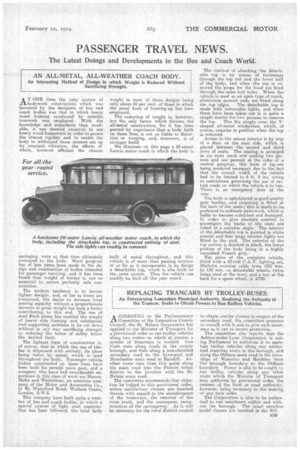PASSENGER TRAVEL NEWS.
Page 23

If you've noticed an error in this article please click here to report it so we can fix it.
The Latest Doings and Developments in the Bus and Coach World.
• AN ALL-METAL, ALL-WEATHER COACH BODY.
An Interesting Method of Design in which Weight is Reduced Without Sacrificing Strength,
AT ONE time the only system of bodywork construction which was favoured by the designers of bus and coach bodies was that in which heavy wood framing reinforced by suitable ironwork was employed. With the knowledge and experience then available, it was deemed essential to use heavy wood framework in order to secure the utmost rigidity and to enable the body to withstand those stresses get up by constant vibration, the effects of which, however efficient the chassis
springing, were at that time ultimately conveyed to the body. Much progress has of late years been made in the design and construction of bodies intended for passenger carrying, and it has been found that weight of timber is not so essential to secure perfectly safe con struction. . , The modern tendency is to favour lighter designs, and, so far as buses are concerned, the desire to increase total seating capacity without a proportionate increase in gross weight has been a factor contributing to this end. The use of steel flitch plates has enabled the weight of heavy side framing and substantial roof-supporting members to be cut down without in any way sacrificing strength Or reducing the factor of safety below the desired limit.
The lightest foIm of construction is, of course, that in which the use of timber is dispensed with entirely, its place being taken by metal, which is used throughout the body. Passenger vehicle bodies constructed on these lines have been built for sevefal years past, and a company who have had considerable experience in this class of work are Messrs. Meltz and Westerman, an associate company of the Motor and Accessories Co., of 40, Waterford Road, Walham Green, London, S.W.6.
This company have built quite a number of bus and coach bodies, in which a special system of light steel construetiqn has been followed, the total betly weight in most of these designs being only about 60 per cent. of those in which the usual form of framing-up has been -employed.
The reduction of weight is, however, not the only factor which favours the all-metal construction, for it has been proved by bxperience that a body built on these lines is not so liable to distortion or warping, and, moreover, is of stronger build.
We illustrate on this page a 20-seater Lancia motor coach in which the body is
built of metal throughout, and this vehicle is of more than passing interest in so far as it iucotperates.in its design a detachable top, which is also built on the same system. Thus the vehicle can readily be used all the year round.
The method of attaching the detachable top is by means of fastenings through the top rail and the lower half of the body, and when the top is removed the props for the hood are fixed through the same bolt boles. When the vehicle is used as an open type of coach, aluminium garnish rails are fitted along the top edges. The detachable top is made with removable lights, and when these have been. taken out it is quite a simple matter for two persons to remove the top. This fits snugly over the Vshaped all-metal windscreen, which, of course, remains in position when the top is removed.
Access to the saloon interior is by way of a door on -the near side, which is placed between the second and third rows of seats. The seating is arranged in six rows (each row seating two persons and one person) at the sides of a central gangway, this form of lay-out being rendered necessary due to the fact that the overall width of the vehicle had to be limited to 6 ft. 2 ins. owing to restrictions governing the use of certain roads on which the vehicle is to run. There is an emergency door at the rear.
The body is upholstered in good quality grey leather, and carpeting is fitted at the back of the seats ; this is Much to be preferred -to ordinary pairrtwork, which is liable to -become scratched and damaged_ In order to give absolute comfort to -passengers the backs of the seats are raked at a suitable angle. The interior a the detachable top is painted in white enamel and four large" interior lights are fitted in the. roof. The exterior of the top section is finished in black, the lower portion of the body being in a highly varnished French grey. ,
The price of the complete vehicle, fitted with a 12-volt C.A.V. lighting $et, Michelin oversize cable tyres (035 mm. . by 135 mm. on detachable wheels, twins being used at the rear), and a box at the back for a spare wheel, is 2750.






























